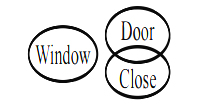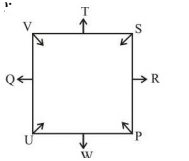Dear Friends, SBI Clerk 2018 Notification has been released we hope you all have started your preparation. Here we have started New Series of Practice Materials specially for SBI Clerk 2018. Aspirants those who are preparing for the exams can use this “20-20” Reasoning Questions.
[WpProQuiz 1186]
Click “Start Quiz” to attend these Questions and view Explanation
Click Here for SBI Clerk Prelims and Mains 2018 – Full Length Mock Test
Directions (Q.1-5): Study the following information carefully and answer the questions given below:
Eight friends P, Q, R, S, T, U, V and W are sitting around a square table. Four of them are sitting in the middle of the sides and facing outward from the center. Rest are sitting in the corners of the square and facing the center. W is sitting in a corner and is an immediate neighbor of P and R. S sits fourth to the right of P and is not facing the center. T is second to the left of W and is an immediate neighbor of V. U is not the neighbor of R.
1). How many persons sit between R and V?
- Two
- One
- None
- Three
- None of these
2).Who among the following sits third to the right of S?
- P
- W
- T
- G
- None of these
3). Which of the following groups sits between T and Q is counted from right of T?
- R, W, P
- R, V, W
- U, V, S
- S, P, W
- None of these
4). Who among the following sits second to the left of U?
- S
- P
- T
- Q
- None of these
5). Four of the following five is alike in a certain way and hence forms a group. Which is the one that does not belong to that group?
- V, U
- T, U
- R, W
- W, P
- S, Q
Directions (Q. 6-10): In each question below are two statements followed by two conclusions numbered I and II. You have to take the two given statements to be true even if they seem to be at variance with commonly known facts. Read all the conditions and then decide which of the given conclusions logically follows from the given statements, disregarding commonly known facts and give answer
a) if only conclusion I follows.
b) if only conclusion II follows.
c) if either conclusion I or II follows.
d) if neither conclusion I nor II follows.
e) if both conclusions I and II follow.
6. Statements: All flowers are red. Some roses are red.
Conclusions: I.All flowers being rose is a possibility.
II.Some flowers are roses.
- Statements: No river is a lake. Some lakes are deep.
Conclusions: I.Some rivers are not deep.
II.At least some lakes are rivers.
- Statements: Some grapes are green. Some fruits are grapes.
Conclusions: I.Some fruits being green is a possibility.
II.Some grapes are not fruits.
- Statements: All cats are dogs. All cats are black.
Conclusions: I.At least some dogs are black.
II.All dogs being cat is a possibility.
10.Statements: No window is a door. No window is close.
Conclusions: I.Some doors being close is a possibility.
II.No door is a window.
Directions (Q.11-15) : Study the following information carefully and answer the questions given below:
Eight friends P, Q, R, S, T, U, V and W are sitting around a square table in such a way that four of them sit at four corners of the square while the remaining four sits at the middle of each of the four sides. Those who sit at the four corners face the centre and those who sit at the middle of the side face outside.
W sits second to the right of R. W does not sit at any of the corners. P sits third to the right of T. T is not an immediate neighbour of R. Q and V are immediate neighbours but Q does not sit at any of the corners of the table. U is an immediate neighbour of neither T nor R.
- Four of the following five are alike in a certain way and so form a group. Which is the one that does not belong to that group?
- T
- Q
- U
- R
- W
- Who sits third to the left of S?
- W
- Q
- R
- T
- Can’t be determined
- What is the position of T with respect to P?
- Immediate to the left
- Second to the left
- Third to the left
- Third to the right
- Second to the right
- Who amongst the following sits second to the right of V?
- R
- S
- W
- U
- P
- Who amongst the following represent the immediate neighbours of U?
- P, V
- W, Q
- W, P
- S, Q
- S, V
Directions (Q.16-20): Study the following information carefully and answer the questions given below.
Ten friends A, B, C, D, E, F, G, H, I and J sit in a straight line. Four of them face South while the remaining six face North. Any of the two friends who face South is neither immediate neighbour of each other nor sits at any extreme ends of the line. A sits fourth to the right of G and fourth to the right of B. G sits on the immediate left of C. H sits between J and I and both of them face South. D sits second to the left of F. I and D are not the immediate neighbours of B. E and F face the same direction.
- How many persons sit between J and F?
- Four
- Three
- Five
- Two
- More than five
- Which of the following pairs respresents the persons seated at the two extreme ends of the line?
- JB
- GC
- AB
- BC
- None of these
- Which of the following is true about D, with respect to the given arrangement?
- One of the immediate neighbours of D faces South.
- D faces North.
- D is between A and E.
- D sits one of the extreme ends of the line.
- All are true
- Who among the following sits second to the left of I?
- D
- A
- J
- E
- None of these
- Four of the following five are alike in a certain way based on the given arrangement and so from a group. Which is the one that does not belong to the group?
- J
- A
- D
- G
- I
Answers:
Directions (Q.1-5):

1). Answer: d
2).Answer: b
3).Answer: a
4).Answer: d
5).Answer: b
Directions (Q. 6-10):
- Answer: a; Possible Venn-diagrams are
Thus, I follow

Thus II does not follow

7. Answer: d

Thus, neither I nor II follows.
8. Answer: a; A possible Venn-diagram is

Thus, only I follows.
- Answer: e; Possible Venn-diagrams are:
Thus, II follows.

Thus, I follows.

- Answer: e; A possible Venn-diagram is

Directions (Q.11-15) :

- Answer: c
- Answer: a
- Answer: d
- Answer: d
- Answer: b
Directions (Q.16-20):
![]()
- Answer: c
- Answer: d
- Answer: c
- Answer: a
- Answer: b
- “20-20” Reasoning Questions | Crack SBI Clerk 2018 Day-1
- “20-20” Reasoning Questions | Crack SBI Clerk 2018 Day-2
- “20-20” Reasoning Questions | Crack SBI Clerk 2018 Day-3
- “20-20” Reasoning Questions | Crack SBI Clerk 2018 Day-4
- “20-20” Reasoning Questions | Crack SBI Clerk 2018 Day-5
- “20-20” Reasoning Questions | Crack SBI Clerk 2018 Day-6
- “20-20” Reasoning Questions | Crack SBI Clerk 2018 Day-7
- “20-20” Reasoning Questions | Crack SBI Clerk 2018 Day-8
- “20-20” Reasoning Questions | Crack SBI Clerk 2018 Day-9
- “20-20” Reasoning Questions | Crack SBI Clerk 2018 Day-10
Click Here for SBI Clerk Prelims and Mains 2018 – Full Length Mock Test





